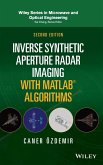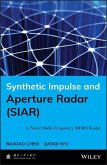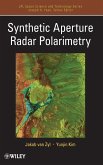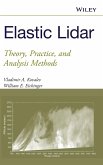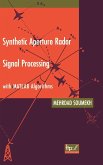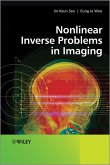Caner Ozdemir
Inverse Synthetic Aperture Radar Imaging With MATLAB Algorithms
Caner Ozdemir
Inverse Synthetic Aperture Radar Imaging With MATLAB Algorithms
- Gebundenes Buch
- Merkliste
- Auf die Merkliste
- Bewerten Bewerten
- Teilen
- Produkt teilen
- Produkterinnerung
- Produkterinnerung
This book provides a full representation of Inverse Synthetic Aperture Radar (ISAR) imagery, which is a popular and important radar signal processing tool. The book covers all possible aspects of ISAR imaging. The book offers a fair amount of signal processing techniques and radar basics before introducing the inverse problem of ISAR and the forward problem of Synthetic Aperture Radar (SAR). Important concepts of SAR such as resolution, pulse compression and image formation are given together with associated MATLAB codes.
After providing the fundamentals for ISAR imaging, the book gives the…mehr
Andere Kunden interessierten sich auch für
![Inverse Synthetic Aperture Radar Imaging with MATLAB Algorithms Inverse Synthetic Aperture Radar Imaging with MATLAB Algorithms]() Caner OzdemirInverse Synthetic Aperture Radar Imaging with MATLAB Algorithms130,99 €
Caner OzdemirInverse Synthetic Aperture Radar Imaging with MATLAB Algorithms130,99 €![Synthetic Impulse and Aperture Radar (Siar) Synthetic Impulse and Aperture Radar (Siar)]() Baixiao ChenSynthetic Impulse and Aperture Radar (Siar)177,99 €
Baixiao ChenSynthetic Impulse and Aperture Radar (Siar)177,99 €![Synthetic Aperture Radar Polarimetry Synthetic Aperture Radar Polarimetry]() Jakob J. Van ZylSynthetic Aperture Radar Polarimetry138,99 €
Jakob J. Van ZylSynthetic Aperture Radar Polarimetry138,99 €![Microwave Imaging Microwave Imaging]() Matteo PastorinoMicrowave Imaging137,99 €
Matteo PastorinoMicrowave Imaging137,99 €![Elastic Lidar Elastic Lidar]() Vladimir A. KovalevElastic Lidar209,99 €
Vladimir A. KovalevElastic Lidar209,99 €![Synthetic Aperture Radar Signal Processing with MATLAB Algorithms Synthetic Aperture Radar Signal Processing with MATLAB Algorithms]() Mehrdad SoumekhSynthetic Aperture Radar Signal Processing with MATLAB Algorithms214,99 €
Mehrdad SoumekhSynthetic Aperture Radar Signal Processing with MATLAB Algorithms214,99 €![Nonlinear Inverse Problems in Imaging Nonlinear Inverse Problems in Imaging]() Jin Keun SeoNonlinear Inverse Problems in Imaging110,99 €
Jin Keun SeoNonlinear Inverse Problems in Imaging110,99 €-
-
-
This book provides a full representation of Inverse Synthetic Aperture Radar (ISAR) imagery, which is a popular and important radar signal processing tool. The book covers all possible aspects of ISAR imaging. The book offers a fair amount of signal processing techniques and radar basics before introducing the inverse problem of ISAR and the forward problem of Synthetic Aperture Radar (SAR). Important concepts of SAR such as resolution, pulse compression and image formation are given together with associated MATLAB codes.
After providing the fundamentals for ISAR imaging, the book gives the detailed imaging procedures for ISAR imaging with associated MATLAB functions and codes. To enhance the image quality in ISAR imaging, several imaging tricks and fine-tuning procedures such as zero-padding and windowing are also presented. Finally, various real applications of ISAR imagery, like imaging the antenna-platform scattering, are given in a separate chapter. For all these algorithms, MATLAB codes and figures are included. The final chapter considers advanced concepts and trends in ISAR imaging.
After providing the fundamentals for ISAR imaging, the book gives the detailed imaging procedures for ISAR imaging with associated MATLAB functions and codes. To enhance the image quality in ISAR imaging, several imaging tricks and fine-tuning procedures such as zero-padding and windowing are also presented. Finally, various real applications of ISAR imagery, like imaging the antenna-platform scattering, are given in a separate chapter. For all these algorithms, MATLAB codes and figures are included. The final chapter considers advanced concepts and trends in ISAR imaging.
Produktdetails
- Produktdetails
- Wiley Series in Microwave and Optical Engineering Vol.1
- Verlag: Wiley & Sons
- 1. Auflage
- Seitenzahl: 416
- Erscheinungstermin: 13. März 2012
- Englisch
- Abmessung: 244mm x 161mm x 35mm
- Gewicht: 696g
- ISBN-13: 9780470284841
- ISBN-10: 0470284846
- Artikelnr.: 33392588
- Herstellerkennzeichnung
- Libri GmbH
- Europaallee 1
- 36244 Bad Hersfeld
- gpsr@libri.de
- Wiley Series in Microwave and Optical Engineering Vol.1
- Verlag: Wiley & Sons
- 1. Auflage
- Seitenzahl: 416
- Erscheinungstermin: 13. März 2012
- Englisch
- Abmessung: 244mm x 161mm x 35mm
- Gewicht: 696g
- ISBN-13: 9780470284841
- ISBN-10: 0470284846
- Artikelnr.: 33392588
- Herstellerkennzeichnung
- Libri GmbH
- Europaallee 1
- 36244 Bad Hersfeld
- gpsr@libri.de
Caner Özdemir, PhD, is Professor of the Department of Electrical-Electronics Engineering at Mersin University and Dean of Faculty of Engineering at Zirve University. Professor Özdemir has performed extensive research in synthetic aperture radar imaging and has developed many novel methods used in inverse synthetic aperture radar imaging.
Preface xiii
Acknowledgments xvii
1 Basics of Fourier Analysis 1
1.1 Forward and Inverse Fourier Transform 1
1.1.1 Brief History of FT 1
1.1.2 Forward FT Operation 2
1.1.3 IFT 2
1.2 FT Rules and Pairs 3
1.2.1 Linearity 3
1.2.2 Time Shifting 3
1.2.3 Frequency Shifting 4
1.2.4 Scaling 4
1.2.5 Duality 4
1.2.6 Time Reversal 4
1.2.7 Conjugation 4
1.2.8 Multiplication 4
1.2.9 Convolution 5
1.2.10 Modulation 5
1.2.11 Derivation and Integration 5
1.2.12 Parseval's Relationship 5
1.3 Time-Frequency Representation of a Signal 5
1.3.1 Signal in the Time Domain 6
1.3.2 Signal in the Frequency Domain 6
1.3.3 Signal in the (JTF) Plane 7
1.4 Convolution and Multiplication Using FT 11
1.5 Filtering/Windowing 11
1.6 Data Sampling 14
1.7 DFT and FFT 14
1.7.1 DFT 14
1.7.2 FFT 16
1.7.3 Bandwidth and Resolutions 18
1.8 Aliasing 19
1.9 Importance of FT in Radar Imaging 19
1.10 Effect of Aliasing in Radar Imaging 22
1.11 Matlab Codes 26
References 31
2 Radar Fundamentals 33
2.1 Electromagnetic (EM) Scattering 33
2.2 Scattering from PECs 36
2.3 Radar Cross Section (RCS) 37
2.3.1 Definition of RCS 38
2.3.2 RCS of Simple Shaped Objects 41
2.3.3 RCS of Complex Shaped Objects 42
2.4 Radar Range Equation 42
2.4.1 Bistatic Case 43
2.4.2 Monostatic Case 48
2.5 Range of Radar Detection 48
2.5.1 Signal-to-Noise Ratio (SNR) 50
2.6 Radar Waveforms 51
2.6.1 CW 51
2.6.2 FMCW 54
2.6.3 SFCW 57
2.6.4 Short Pulse 60
2.6.5 Chirp (LFM) Pulse 62
2.7 Pulsed Radar 65
2.7.1 PRF 65
2.7.2 Maximum Range and Range Ambiguity 67
2.7.3 Doppler Frequency 68
2.8 Matlab Codes 72
References 77
3 Synthetic Aperture Radar 79
3.1 SAR Modes 80
3.2 SAR System Design 80
3.3 Resolutions in SAR 83
3.4 SAR Image Formation: Range and Azimuth Compression 85
3.5 Range Compression 86
3.5.1 Matched Filter 86
3.5.2 Ambiguity Function 90
3.6 Pulse Compression 96
3.6.1 Detailed Processing of Pulse Compression 97
3.6.2 Bandwidth, Resolution, and Compression Issues 100
3.6.3 Pulse Compression Example 101
3.7 Azimuth Compression 102
3.7.1 Processing in Azimuth 102
3.7.2 Azimuth Resolution 106
3.7.3 Relation to ISAR 107
3.8 SAR Imaging 108
3.9 Example of SAR Imagery 108
3.10 Problems in SAR Imaging 110
3.10.1 Range Migration 110
3.10.2 Motion Errors 111
3.10.3 Speckle Noise 112
3.11 Advanced Topics in SAR 112
3.11.1 SAR Interferometry 112
3.11.2 SAR Polarimetry 113
3.12 Matlab Codes 114
References 120
4 Inverse Synthetic Aperture Radar Imaging and Its Basic Concepts 121
4.1 SAR versus ISAR 121
4.2 The Relation of Scattered Field to the Image Function in ISAR 125
4.3 One-Dimensional (1D) Range Profile 126
4.4 1D Cross-Range Profile 131
4.5 2D ISAR Image Formation (Small Bandwidth, Small Angle) 133
4.5.1 Range and Cross-Range Resolutions 139
4.5.2 Range and Cross-Range Extends 140
4.5.3 Imaging Multi-Bounces in ISAR 140
4.5.4 Sample Design Procedure for ISAR 144
4.6 2D ISAR Image Formation (Wide Bandwidth, Large Angles) 152
4.6.1 Direct Integration 154
4.6.2 Polar Reformatting 158
4.7 3D ISAR Image Formation 159
4.7.1 Range and Cross-Range Resolutions 165
4.7.2 A Design Example 165
4.8 Matlab Codes 169
References 185
5 Imaging Issues in Inverse Synthetic Aperture Radar 187
5.1 Fourier-Related Issues 187
5.1.1 DFT Revisited 188
5.1.2 Positive and Negative Frequencies in DFT 191
5.2 Image Aliasing 194
5.3 Polar Reformatting Revisited 196
5.3.1 Nearest Neighbor Interpolation 196
5.3.2 Bilinear Interpolation 198
5.4 Zero Padding 200
5.5 Point Spread Function (PSF) 202
5.6 Windowing 205
5.6.1 Common Windowing Functions 205
5.6.2 ISAR Image Smoothing via Windowing 212
5.7 Matlab Codes 213
References 229
6 Range-Doppler Inverse Synthetic Aperture Radar Processing 231
6.1 Scenarios for ISAR 232
6.1.1 Imaging Aerial Targets via Ground-Based Radar 232
6.1.2 Imaging Ground/Sea Targets via Aerial Radar 234
6.2 ISAR Waveforms for Range-Doppler Processing 237
6.2.1 Chirp Pulse Train 238
6.2.2 Stepped Frequency Pulse Train 239
6.3 Doppler Shift's Relation to Cross Range 241
6.3.1 Doppler Frequency Shift Resolution 242
6.3.2 Resolving Doppler Shift and Cross Range 243
6.4 Forming the Range-Doppler Image 244
6.5 ISAR Receiver 245
6.5.1 ISAR Receiver for Chirp Pulse Radar 245
6.5.2 ISAR Receiver for SFCW Radar 246
6.6 Quadradure Detection 247
6.6.1 I-Channel Processing 248
6.6.2 Q-Channel Processing 249
6.7 Range Alignment 250
6.8 Defining the Range-Doppler ISAR Imaging Parameters 252
6.8.1 Image Frame Dimension (Image Extends) 252
6.8.2 Range-Cross-Range Resolution 253
6.8.3 Frequency Bandwidth and the Center Frequency 253
6.8.4 Doppler Frequency Bandwidth 254
6.8.5 PRF 254
6.8.6 Coherent Integration (Dwell) Time 255
6.8.7 Pulse Width 256
6.9 Example of Chirp Pulse-Based Range-Doppler ISAR Imaging 256
6.10 Example of SFCW-Based Range-Doppler ISAR Imaging 262
6.11 Matlab Codes 264
References 270
7 Scattering Center Representation of Inverse Synthetic Aperture Radar 271
7.1 Scattering/Radiation Center Model 272
7.2 Extraction of Scattering Centers 274
7.2.1 Image Domain Formulation 274
7.2.2 Fourier Domain Formulation 283
7.3 Matlab Codes 287
References 297
8 Motion Compensation for Inverse Synthetic Aperture Radar 299
8.1 Doppler Effect Due to Target Motion 300
8.2 Standard MOCOMP Procedures 302
8.2.1 Translational MOCOMP 303
8.2.2 Rotational MOCOMP 304
8.3 Popular MOCOMP Techniques in ISAR 306
8.3.1 Cross-Correlation Method 306
8.3.2 Minimum Entropy Method 311
8.3.3 JTF-Based MOCOMP 316
8.3.4 Algorithm for JTF-Based Translational and Rotational MOCOMP 321
8.4 Matlab Codes 328
References 342
9 Some Imaging Applications Based on Inverse Synthetic Aperture Radar 345
9.1 Imaging Antenna-Platform Scattering: ASAR 346
9.1.1 The ASAR Imaging Algorithm 347
9.1.2 Numerical Example for ASAR Imagery 352
9.2 Imaging Platform Coupling between Antennas: ACSAR 353
9.2.1 The ACSAR Imaging Algorithm 356
9.2.2 Numerical Example for ACSAR 358
9.3 Imaging Scattering from Subsurface Objects: GPR-SAR 359
9.3.1 The GPR Problem 362
9.3.2 Focused GPR Images Using SAR 364
9.3.3 Applying ACSAR Concept to the GPR Problem 369
References 372
Appendix 375
Index 379
Acknowledgments xvii
1 Basics of Fourier Analysis 1
1.1 Forward and Inverse Fourier Transform 1
1.1.1 Brief History of FT 1
1.1.2 Forward FT Operation 2
1.1.3 IFT 2
1.2 FT Rules and Pairs 3
1.2.1 Linearity 3
1.2.2 Time Shifting 3
1.2.3 Frequency Shifting 4
1.2.4 Scaling 4
1.2.5 Duality 4
1.2.6 Time Reversal 4
1.2.7 Conjugation 4
1.2.8 Multiplication 4
1.2.9 Convolution 5
1.2.10 Modulation 5
1.2.11 Derivation and Integration 5
1.2.12 Parseval's Relationship 5
1.3 Time-Frequency Representation of a Signal 5
1.3.1 Signal in the Time Domain 6
1.3.2 Signal in the Frequency Domain 6
1.3.3 Signal in the (JTF) Plane 7
1.4 Convolution and Multiplication Using FT 11
1.5 Filtering/Windowing 11
1.6 Data Sampling 14
1.7 DFT and FFT 14
1.7.1 DFT 14
1.7.2 FFT 16
1.7.3 Bandwidth and Resolutions 18
1.8 Aliasing 19
1.9 Importance of FT in Radar Imaging 19
1.10 Effect of Aliasing in Radar Imaging 22
1.11 Matlab Codes 26
References 31
2 Radar Fundamentals 33
2.1 Electromagnetic (EM) Scattering 33
2.2 Scattering from PECs 36
2.3 Radar Cross Section (RCS) 37
2.3.1 Definition of RCS 38
2.3.2 RCS of Simple Shaped Objects 41
2.3.3 RCS of Complex Shaped Objects 42
2.4 Radar Range Equation 42
2.4.1 Bistatic Case 43
2.4.2 Monostatic Case 48
2.5 Range of Radar Detection 48
2.5.1 Signal-to-Noise Ratio (SNR) 50
2.6 Radar Waveforms 51
2.6.1 CW 51
2.6.2 FMCW 54
2.6.3 SFCW 57
2.6.4 Short Pulse 60
2.6.5 Chirp (LFM) Pulse 62
2.7 Pulsed Radar 65
2.7.1 PRF 65
2.7.2 Maximum Range and Range Ambiguity 67
2.7.3 Doppler Frequency 68
2.8 Matlab Codes 72
References 77
3 Synthetic Aperture Radar 79
3.1 SAR Modes 80
3.2 SAR System Design 80
3.3 Resolutions in SAR 83
3.4 SAR Image Formation: Range and Azimuth Compression 85
3.5 Range Compression 86
3.5.1 Matched Filter 86
3.5.2 Ambiguity Function 90
3.6 Pulse Compression 96
3.6.1 Detailed Processing of Pulse Compression 97
3.6.2 Bandwidth, Resolution, and Compression Issues 100
3.6.3 Pulse Compression Example 101
3.7 Azimuth Compression 102
3.7.1 Processing in Azimuth 102
3.7.2 Azimuth Resolution 106
3.7.3 Relation to ISAR 107
3.8 SAR Imaging 108
3.9 Example of SAR Imagery 108
3.10 Problems in SAR Imaging 110
3.10.1 Range Migration 110
3.10.2 Motion Errors 111
3.10.3 Speckle Noise 112
3.11 Advanced Topics in SAR 112
3.11.1 SAR Interferometry 112
3.11.2 SAR Polarimetry 113
3.12 Matlab Codes 114
References 120
4 Inverse Synthetic Aperture Radar Imaging and Its Basic Concepts 121
4.1 SAR versus ISAR 121
4.2 The Relation of Scattered Field to the Image Function in ISAR 125
4.3 One-Dimensional (1D) Range Profile 126
4.4 1D Cross-Range Profile 131
4.5 2D ISAR Image Formation (Small Bandwidth, Small Angle) 133
4.5.1 Range and Cross-Range Resolutions 139
4.5.2 Range and Cross-Range Extends 140
4.5.3 Imaging Multi-Bounces in ISAR 140
4.5.4 Sample Design Procedure for ISAR 144
4.6 2D ISAR Image Formation (Wide Bandwidth, Large Angles) 152
4.6.1 Direct Integration 154
4.6.2 Polar Reformatting 158
4.7 3D ISAR Image Formation 159
4.7.1 Range and Cross-Range Resolutions 165
4.7.2 A Design Example 165
4.8 Matlab Codes 169
References 185
5 Imaging Issues in Inverse Synthetic Aperture Radar 187
5.1 Fourier-Related Issues 187
5.1.1 DFT Revisited 188
5.1.2 Positive and Negative Frequencies in DFT 191
5.2 Image Aliasing 194
5.3 Polar Reformatting Revisited 196
5.3.1 Nearest Neighbor Interpolation 196
5.3.2 Bilinear Interpolation 198
5.4 Zero Padding 200
5.5 Point Spread Function (PSF) 202
5.6 Windowing 205
5.6.1 Common Windowing Functions 205
5.6.2 ISAR Image Smoothing via Windowing 212
5.7 Matlab Codes 213
References 229
6 Range-Doppler Inverse Synthetic Aperture Radar Processing 231
6.1 Scenarios for ISAR 232
6.1.1 Imaging Aerial Targets via Ground-Based Radar 232
6.1.2 Imaging Ground/Sea Targets via Aerial Radar 234
6.2 ISAR Waveforms for Range-Doppler Processing 237
6.2.1 Chirp Pulse Train 238
6.2.2 Stepped Frequency Pulse Train 239
6.3 Doppler Shift's Relation to Cross Range 241
6.3.1 Doppler Frequency Shift Resolution 242
6.3.2 Resolving Doppler Shift and Cross Range 243
6.4 Forming the Range-Doppler Image 244
6.5 ISAR Receiver 245
6.5.1 ISAR Receiver for Chirp Pulse Radar 245
6.5.2 ISAR Receiver for SFCW Radar 246
6.6 Quadradure Detection 247
6.6.1 I-Channel Processing 248
6.6.2 Q-Channel Processing 249
6.7 Range Alignment 250
6.8 Defining the Range-Doppler ISAR Imaging Parameters 252
6.8.1 Image Frame Dimension (Image Extends) 252
6.8.2 Range-Cross-Range Resolution 253
6.8.3 Frequency Bandwidth and the Center Frequency 253
6.8.4 Doppler Frequency Bandwidth 254
6.8.5 PRF 254
6.8.6 Coherent Integration (Dwell) Time 255
6.8.7 Pulse Width 256
6.9 Example of Chirp Pulse-Based Range-Doppler ISAR Imaging 256
6.10 Example of SFCW-Based Range-Doppler ISAR Imaging 262
6.11 Matlab Codes 264
References 270
7 Scattering Center Representation of Inverse Synthetic Aperture Radar 271
7.1 Scattering/Radiation Center Model 272
7.2 Extraction of Scattering Centers 274
7.2.1 Image Domain Formulation 274
7.2.2 Fourier Domain Formulation 283
7.3 Matlab Codes 287
References 297
8 Motion Compensation for Inverse Synthetic Aperture Radar 299
8.1 Doppler Effect Due to Target Motion 300
8.2 Standard MOCOMP Procedures 302
8.2.1 Translational MOCOMP 303
8.2.2 Rotational MOCOMP 304
8.3 Popular MOCOMP Techniques in ISAR 306
8.3.1 Cross-Correlation Method 306
8.3.2 Minimum Entropy Method 311
8.3.3 JTF-Based MOCOMP 316
8.3.4 Algorithm for JTF-Based Translational and Rotational MOCOMP 321
8.4 Matlab Codes 328
References 342
9 Some Imaging Applications Based on Inverse Synthetic Aperture Radar 345
9.1 Imaging Antenna-Platform Scattering: ASAR 346
9.1.1 The ASAR Imaging Algorithm 347
9.1.2 Numerical Example for ASAR Imagery 352
9.2 Imaging Platform Coupling between Antennas: ACSAR 353
9.2.1 The ACSAR Imaging Algorithm 356
9.2.2 Numerical Example for ACSAR 358
9.3 Imaging Scattering from Subsurface Objects: GPR-SAR 359
9.3.1 The GPR Problem 362
9.3.2 Focused GPR Images Using SAR 364
9.3.3 Applying ACSAR Concept to the GPR Problem 369
References 372
Appendix 375
Index 379
Preface xiii
Acknowledgments xvii
1 Basics of Fourier Analysis 1
1.1 Forward and Inverse Fourier Transform 1
1.1.1 Brief History of FT 1
1.1.2 Forward FT Operation 2
1.1.3 IFT 2
1.2 FT Rules and Pairs 3
1.2.1 Linearity 3
1.2.2 Time Shifting 3
1.2.3 Frequency Shifting 4
1.2.4 Scaling 4
1.2.5 Duality 4
1.2.6 Time Reversal 4
1.2.7 Conjugation 4
1.2.8 Multiplication 4
1.2.9 Convolution 5
1.2.10 Modulation 5
1.2.11 Derivation and Integration 5
1.2.12 Parseval's Relationship 5
1.3 Time-Frequency Representation of a Signal 5
1.3.1 Signal in the Time Domain 6
1.3.2 Signal in the Frequency Domain 6
1.3.3 Signal in the (JTF) Plane 7
1.4 Convolution and Multiplication Using FT 11
1.5 Filtering/Windowing 11
1.6 Data Sampling 14
1.7 DFT and FFT 14
1.7.1 DFT 14
1.7.2 FFT 16
1.7.3 Bandwidth and Resolutions 18
1.8 Aliasing 19
1.9 Importance of FT in Radar Imaging 19
1.10 Effect of Aliasing in Radar Imaging 22
1.11 Matlab Codes 26
References 31
2 Radar Fundamentals 33
2.1 Electromagnetic (EM) Scattering 33
2.2 Scattering from PECs 36
2.3 Radar Cross Section (RCS) 37
2.3.1 Definition of RCS 38
2.3.2 RCS of Simple Shaped Objects 41
2.3.3 RCS of Complex Shaped Objects 42
2.4 Radar Range Equation 42
2.4.1 Bistatic Case 43
2.4.2 Monostatic Case 48
2.5 Range of Radar Detection 48
2.5.1 Signal-to-Noise Ratio (SNR) 50
2.6 Radar Waveforms 51
2.6.1 CW 51
2.6.2 FMCW 54
2.6.3 SFCW 57
2.6.4 Short Pulse 60
2.6.5 Chirp (LFM) Pulse 62
2.7 Pulsed Radar 65
2.7.1 PRF 65
2.7.2 Maximum Range and Range Ambiguity 67
2.7.3 Doppler Frequency 68
2.8 Matlab Codes 72
References 77
3 Synthetic Aperture Radar 79
3.1 SAR Modes 80
3.2 SAR System Design 80
3.3 Resolutions in SAR 83
3.4 SAR Image Formation: Range and Azimuth Compression 85
3.5 Range Compression 86
3.5.1 Matched Filter 86
3.5.2 Ambiguity Function 90
3.6 Pulse Compression 96
3.6.1 Detailed Processing of Pulse Compression 97
3.6.2 Bandwidth, Resolution, and Compression Issues 100
3.6.3 Pulse Compression Example 101
3.7 Azimuth Compression 102
3.7.1 Processing in Azimuth 102
3.7.2 Azimuth Resolution 106
3.7.3 Relation to ISAR 107
3.8 SAR Imaging 108
3.9 Example of SAR Imagery 108
3.10 Problems in SAR Imaging 110
3.10.1 Range Migration 110
3.10.2 Motion Errors 111
3.10.3 Speckle Noise 112
3.11 Advanced Topics in SAR 112
3.11.1 SAR Interferometry 112
3.11.2 SAR Polarimetry 113
3.12 Matlab Codes 114
References 120
4 Inverse Synthetic Aperture Radar Imaging and Its Basic Concepts 121
4.1 SAR versus ISAR 121
4.2 The Relation of Scattered Field to the Image Function in ISAR 125
4.3 One-Dimensional (1D) Range Profile 126
4.4 1D Cross-Range Profile 131
4.5 2D ISAR Image Formation (Small Bandwidth, Small Angle) 133
4.5.1 Range and Cross-Range Resolutions 139
4.5.2 Range and Cross-Range Extends 140
4.5.3 Imaging Multi-Bounces in ISAR 140
4.5.4 Sample Design Procedure for ISAR 144
4.6 2D ISAR Image Formation (Wide Bandwidth, Large Angles) 152
4.6.1 Direct Integration 154
4.6.2 Polar Reformatting 158
4.7 3D ISAR Image Formation 159
4.7.1 Range and Cross-Range Resolutions 165
4.7.2 A Design Example 165
4.8 Matlab Codes 169
References 185
5 Imaging Issues in Inverse Synthetic Aperture Radar 187
5.1 Fourier-Related Issues 187
5.1.1 DFT Revisited 188
5.1.2 Positive and Negative Frequencies in DFT 191
5.2 Image Aliasing 194
5.3 Polar Reformatting Revisited 196
5.3.1 Nearest Neighbor Interpolation 196
5.3.2 Bilinear Interpolation 198
5.4 Zero Padding 200
5.5 Point Spread Function (PSF) 202
5.6 Windowing 205
5.6.1 Common Windowing Functions 205
5.6.2 ISAR Image Smoothing via Windowing 212
5.7 Matlab Codes 213
References 229
6 Range-Doppler Inverse Synthetic Aperture Radar Processing 231
6.1 Scenarios for ISAR 232
6.1.1 Imaging Aerial Targets via Ground-Based Radar 232
6.1.2 Imaging Ground/Sea Targets via Aerial Radar 234
6.2 ISAR Waveforms for Range-Doppler Processing 237
6.2.1 Chirp Pulse Train 238
6.2.2 Stepped Frequency Pulse Train 239
6.3 Doppler Shift's Relation to Cross Range 241
6.3.1 Doppler Frequency Shift Resolution 242
6.3.2 Resolving Doppler Shift and Cross Range 243
6.4 Forming the Range-Doppler Image 244
6.5 ISAR Receiver 245
6.5.1 ISAR Receiver for Chirp Pulse Radar 245
6.5.2 ISAR Receiver for SFCW Radar 246
6.6 Quadradure Detection 247
6.6.1 I-Channel Processing 248
6.6.2 Q-Channel Processing 249
6.7 Range Alignment 250
6.8 Defining the Range-Doppler ISAR Imaging Parameters 252
6.8.1 Image Frame Dimension (Image Extends) 252
6.8.2 Range-Cross-Range Resolution 253
6.8.3 Frequency Bandwidth and the Center Frequency 253
6.8.4 Doppler Frequency Bandwidth 254
6.8.5 PRF 254
6.8.6 Coherent Integration (Dwell) Time 255
6.8.7 Pulse Width 256
6.9 Example of Chirp Pulse-Based Range-Doppler ISAR Imaging 256
6.10 Example of SFCW-Based Range-Doppler ISAR Imaging 262
6.11 Matlab Codes 264
References 270
7 Scattering Center Representation of Inverse Synthetic Aperture Radar 271
7.1 Scattering/Radiation Center Model 272
7.2 Extraction of Scattering Centers 274
7.2.1 Image Domain Formulation 274
7.2.2 Fourier Domain Formulation 283
7.3 Matlab Codes 287
References 297
8 Motion Compensation for Inverse Synthetic Aperture Radar 299
8.1 Doppler Effect Due to Target Motion 300
8.2 Standard MOCOMP Procedures 302
8.2.1 Translational MOCOMP 303
8.2.2 Rotational MOCOMP 304
8.3 Popular MOCOMP Techniques in ISAR 306
8.3.1 Cross-Correlation Method 306
8.3.2 Minimum Entropy Method 311
8.3.3 JTF-Based MOCOMP 316
8.3.4 Algorithm for JTF-Based Translational and Rotational MOCOMP 321
8.4 Matlab Codes 328
References 342
9 Some Imaging Applications Based on Inverse Synthetic Aperture Radar 345
9.1 Imaging Antenna-Platform Scattering: ASAR 346
9.1.1 The ASAR Imaging Algorithm 347
9.1.2 Numerical Example for ASAR Imagery 352
9.2 Imaging Platform Coupling between Antennas: ACSAR 353
9.2.1 The ACSAR Imaging Algorithm 356
9.2.2 Numerical Example for ACSAR 358
9.3 Imaging Scattering from Subsurface Objects: GPR-SAR 359
9.3.1 The GPR Problem 362
9.3.2 Focused GPR Images Using SAR 364
9.3.3 Applying ACSAR Concept to the GPR Problem 369
References 372
Appendix 375
Index 379
Acknowledgments xvii
1 Basics of Fourier Analysis 1
1.1 Forward and Inverse Fourier Transform 1
1.1.1 Brief History of FT 1
1.1.2 Forward FT Operation 2
1.1.3 IFT 2
1.2 FT Rules and Pairs 3
1.2.1 Linearity 3
1.2.2 Time Shifting 3
1.2.3 Frequency Shifting 4
1.2.4 Scaling 4
1.2.5 Duality 4
1.2.6 Time Reversal 4
1.2.7 Conjugation 4
1.2.8 Multiplication 4
1.2.9 Convolution 5
1.2.10 Modulation 5
1.2.11 Derivation and Integration 5
1.2.12 Parseval's Relationship 5
1.3 Time-Frequency Representation of a Signal 5
1.3.1 Signal in the Time Domain 6
1.3.2 Signal in the Frequency Domain 6
1.3.3 Signal in the (JTF) Plane 7
1.4 Convolution and Multiplication Using FT 11
1.5 Filtering/Windowing 11
1.6 Data Sampling 14
1.7 DFT and FFT 14
1.7.1 DFT 14
1.7.2 FFT 16
1.7.3 Bandwidth and Resolutions 18
1.8 Aliasing 19
1.9 Importance of FT in Radar Imaging 19
1.10 Effect of Aliasing in Radar Imaging 22
1.11 Matlab Codes 26
References 31
2 Radar Fundamentals 33
2.1 Electromagnetic (EM) Scattering 33
2.2 Scattering from PECs 36
2.3 Radar Cross Section (RCS) 37
2.3.1 Definition of RCS 38
2.3.2 RCS of Simple Shaped Objects 41
2.3.3 RCS of Complex Shaped Objects 42
2.4 Radar Range Equation 42
2.4.1 Bistatic Case 43
2.4.2 Monostatic Case 48
2.5 Range of Radar Detection 48
2.5.1 Signal-to-Noise Ratio (SNR) 50
2.6 Radar Waveforms 51
2.6.1 CW 51
2.6.2 FMCW 54
2.6.3 SFCW 57
2.6.4 Short Pulse 60
2.6.5 Chirp (LFM) Pulse 62
2.7 Pulsed Radar 65
2.7.1 PRF 65
2.7.2 Maximum Range and Range Ambiguity 67
2.7.3 Doppler Frequency 68
2.8 Matlab Codes 72
References 77
3 Synthetic Aperture Radar 79
3.1 SAR Modes 80
3.2 SAR System Design 80
3.3 Resolutions in SAR 83
3.4 SAR Image Formation: Range and Azimuth Compression 85
3.5 Range Compression 86
3.5.1 Matched Filter 86
3.5.2 Ambiguity Function 90
3.6 Pulse Compression 96
3.6.1 Detailed Processing of Pulse Compression 97
3.6.2 Bandwidth, Resolution, and Compression Issues 100
3.6.3 Pulse Compression Example 101
3.7 Azimuth Compression 102
3.7.1 Processing in Azimuth 102
3.7.2 Azimuth Resolution 106
3.7.3 Relation to ISAR 107
3.8 SAR Imaging 108
3.9 Example of SAR Imagery 108
3.10 Problems in SAR Imaging 110
3.10.1 Range Migration 110
3.10.2 Motion Errors 111
3.10.3 Speckle Noise 112
3.11 Advanced Topics in SAR 112
3.11.1 SAR Interferometry 112
3.11.2 SAR Polarimetry 113
3.12 Matlab Codes 114
References 120
4 Inverse Synthetic Aperture Radar Imaging and Its Basic Concepts 121
4.1 SAR versus ISAR 121
4.2 The Relation of Scattered Field to the Image Function in ISAR 125
4.3 One-Dimensional (1D) Range Profile 126
4.4 1D Cross-Range Profile 131
4.5 2D ISAR Image Formation (Small Bandwidth, Small Angle) 133
4.5.1 Range and Cross-Range Resolutions 139
4.5.2 Range and Cross-Range Extends 140
4.5.3 Imaging Multi-Bounces in ISAR 140
4.5.4 Sample Design Procedure for ISAR 144
4.6 2D ISAR Image Formation (Wide Bandwidth, Large Angles) 152
4.6.1 Direct Integration 154
4.6.2 Polar Reformatting 158
4.7 3D ISAR Image Formation 159
4.7.1 Range and Cross-Range Resolutions 165
4.7.2 A Design Example 165
4.8 Matlab Codes 169
References 185
5 Imaging Issues in Inverse Synthetic Aperture Radar 187
5.1 Fourier-Related Issues 187
5.1.1 DFT Revisited 188
5.1.2 Positive and Negative Frequencies in DFT 191
5.2 Image Aliasing 194
5.3 Polar Reformatting Revisited 196
5.3.1 Nearest Neighbor Interpolation 196
5.3.2 Bilinear Interpolation 198
5.4 Zero Padding 200
5.5 Point Spread Function (PSF) 202
5.6 Windowing 205
5.6.1 Common Windowing Functions 205
5.6.2 ISAR Image Smoothing via Windowing 212
5.7 Matlab Codes 213
References 229
6 Range-Doppler Inverse Synthetic Aperture Radar Processing 231
6.1 Scenarios for ISAR 232
6.1.1 Imaging Aerial Targets via Ground-Based Radar 232
6.1.2 Imaging Ground/Sea Targets via Aerial Radar 234
6.2 ISAR Waveforms for Range-Doppler Processing 237
6.2.1 Chirp Pulse Train 238
6.2.2 Stepped Frequency Pulse Train 239
6.3 Doppler Shift's Relation to Cross Range 241
6.3.1 Doppler Frequency Shift Resolution 242
6.3.2 Resolving Doppler Shift and Cross Range 243
6.4 Forming the Range-Doppler Image 244
6.5 ISAR Receiver 245
6.5.1 ISAR Receiver for Chirp Pulse Radar 245
6.5.2 ISAR Receiver for SFCW Radar 246
6.6 Quadradure Detection 247
6.6.1 I-Channel Processing 248
6.6.2 Q-Channel Processing 249
6.7 Range Alignment 250
6.8 Defining the Range-Doppler ISAR Imaging Parameters 252
6.8.1 Image Frame Dimension (Image Extends) 252
6.8.2 Range-Cross-Range Resolution 253
6.8.3 Frequency Bandwidth and the Center Frequency 253
6.8.4 Doppler Frequency Bandwidth 254
6.8.5 PRF 254
6.8.6 Coherent Integration (Dwell) Time 255
6.8.7 Pulse Width 256
6.9 Example of Chirp Pulse-Based Range-Doppler ISAR Imaging 256
6.10 Example of SFCW-Based Range-Doppler ISAR Imaging 262
6.11 Matlab Codes 264
References 270
7 Scattering Center Representation of Inverse Synthetic Aperture Radar 271
7.1 Scattering/Radiation Center Model 272
7.2 Extraction of Scattering Centers 274
7.2.1 Image Domain Formulation 274
7.2.2 Fourier Domain Formulation 283
7.3 Matlab Codes 287
References 297
8 Motion Compensation for Inverse Synthetic Aperture Radar 299
8.1 Doppler Effect Due to Target Motion 300
8.2 Standard MOCOMP Procedures 302
8.2.1 Translational MOCOMP 303
8.2.2 Rotational MOCOMP 304
8.3 Popular MOCOMP Techniques in ISAR 306
8.3.1 Cross-Correlation Method 306
8.3.2 Minimum Entropy Method 311
8.3.3 JTF-Based MOCOMP 316
8.3.4 Algorithm for JTF-Based Translational and Rotational MOCOMP 321
8.4 Matlab Codes 328
References 342
9 Some Imaging Applications Based on Inverse Synthetic Aperture Radar 345
9.1 Imaging Antenna-Platform Scattering: ASAR 346
9.1.1 The ASAR Imaging Algorithm 347
9.1.2 Numerical Example for ASAR Imagery 352
9.2 Imaging Platform Coupling between Antennas: ACSAR 353
9.2.1 The ACSAR Imaging Algorithm 356
9.2.2 Numerical Example for ACSAR 358
9.3 Imaging Scattering from Subsurface Objects: GPR-SAR 359
9.3.1 The GPR Problem 362
9.3.2 Focused GPR Images Using SAR 364
9.3.3 Applying ACSAR Concept to the GPR Problem 369
References 372
Appendix 375
Index 379


